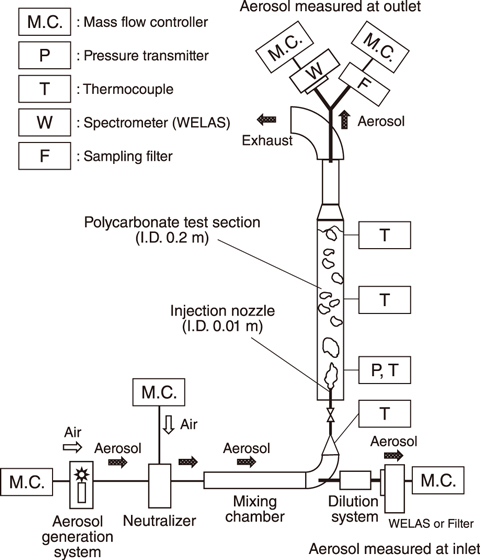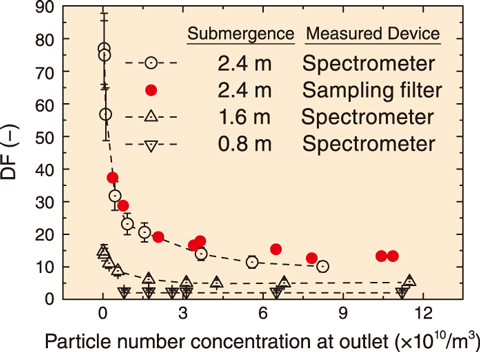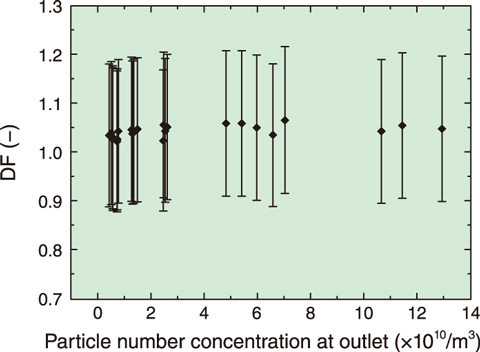
Fig.2-4 Schematic of experimental apparatus (PONTUS)

Fig.2-5 Relationship between DF and particle concentration for each water submergence

Fig.2-6 Relationship between DF and particle concentration in an empty test section
Pool scrubbing can effectively reduce fission product release to the environment during a severe accident of a nuclear reactor. Since scrubbing has a relatively high decontamination factor (DF) and a large impact on the evaluation of source term (defined by generation and release rate of contaminant in the event of an accident), it has been widely studied as an important nuclear safety issue. JAEA is currently conducting experimental research to reveal the interaction mechanism between an aerosol and two-phase flow in the pool. This work has aimed to reduce the uncertainty of measuring aerosol and improve the reliability, both of which have been regarded as important issues in previous studies.
The results indicated that the DF increased significantly with decreasing particle number density in the condition of the particle concentration without significant collision and/or agglomeration. As this phenomenon has hardly been investigated in the past, even though it may clarify the physical mechanism of pool scrubbing, the characteristics were studied in detail.
A schematic of the designed experimental apparatus (named PONTUS) is shown in Fig.2-4. By using air as a carrier gas, monodispersed SiO2 (particle size diameter of 0.5 μm) as an aerosol, and fixed thermal-hydraulic parameters such as injection flowrate and/or pool water depth, the DFs for each water depth were measured by changing only the particle number concentration as a test parameter. At a water depth of 2.4 m, aerosol spectrometers and filter sampling which have different measurement principles were both used to ensure measurement reliability; the results are shown in Fig.2-5. The DF results were consistent across both measurement types, indicating the data reliability and the dependence of DF on particle number concentration. The DF increased remarkably with decreasing particle number concentration. To ensure the generality of the acquired data which is not facility dependent, the DF was also measured in an empty test section without pool water in the same test section. As shown in Fig.2-6, the DF in the empty test section indicated a constant value regardless of the particle concentration, and the value is close to the ideal 1, showing the appropriateness of facility design. The resulting DF under water submergence of 0.8 m and 1.6 m is also shown in Fig.2-5. Thus, the dependence of DF on the concentration becomes more significant as the deeper water submergence. Therefore, it is considered that the dependency on particle number concentration plays a more dominant role in the bubble rising region downstream from the injection than in the gas injection region.
Overall, the effect of particle number concentration on the DF increased under high water depth and low particle number concentration. Based on these findings, future work will aim to improve the pool scrubbing model related to this phenomenon.
This study was conducted as part of the contract research sponsored by the Secretariat of the Nuclear Regulation Authority (NRA), Japan.